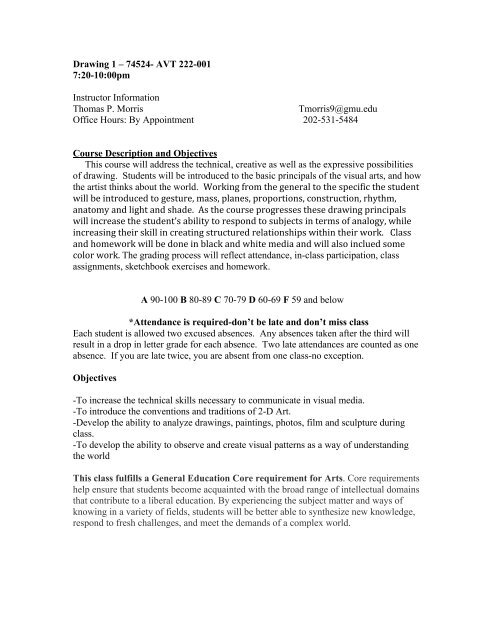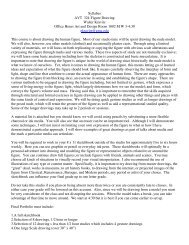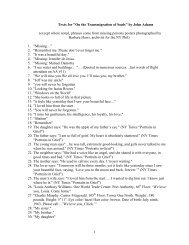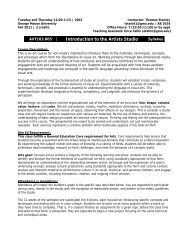222 Drawing I Morris.pdf - George Mason University
222 Drawing I Morris.pdf - George Mason University
222 Drawing I Morris.pdf - George Mason University
Create successful ePaper yourself
Turn your PDF publications into a flip-book with our unique Google optimized e-Paper software.
<strong>Drawing</strong> 1 – 74524- AVT <strong>222</strong>-0017:20-10:00pmInstructor InformationThomas P. <strong>Morris</strong>Tmorris9@gmu.eduOffice Hours: By Appointment 202-531-5484Course Description and ObjectivesThis course will address the technical, creative as well as the expressive possibilitiesof drawing. Students will be introduced to the basic principals of the visual arts, and howthe artist thinks about the world. Working from the general to the specific the student will be introduced to gesture, mass, planes, proportions, construction, rhythm, anatomy and light and shade. As the course progresses these drawing principals will increase the student’s ability to respond to subjects in terms of analogy, while increasing their skill in creating structured relationships within their work. Class and homework will be done in black and white media and will also inclued some color work. The grading process will reflect attendance, in-class participation, classassignments, sketchbook exercises and homework.A 90-100 B 80-89 C 70-79 D 60-69 F 59 and below*Attendance is required-don’t be late and don’t miss classEach student is allowed two excused absences. Any absences taken after the third willresult in a drop in letter grade for each absence. Two late attendances are counted as oneabsence. If you are late twice, you are absent from one class-no exception.Objectives-To increase the technical skills necessary to communicate in visual media.-To introduce the conventions and traditions of 2-D Art.-Develop the ability to analyze drawings, paintings, photos, film and sculpture duringclass.-To develop the ability to observe and create visual patterns as a way of understandingthe worldThis class fulfills a General Education Core requirement for Arts. Core requirementshelp ensure that students become acquainted with the broad range of intellectual domainsthat contribute to a liberal education. By experiencing the subject matter and ways ofknowing in a variety of fields, students will be better able to synthesize new knowledge,respond to fresh challenges, and meet the demands of a complex world.
Arts goal: Courses aim to achieve a majority of the following learning outcomes:students will be able to identify and analyze the formal elements of a particular art formusing vocabulary appropriate to that form; demonstrate an understanding of therelationship between artistic technique and the expression of a work’s underlyingconcept; analyze cultural productions using standards appropriate to the form and culturalcontext; analyze and interpret material or performance culture in its social, historical, andpersonal contexts; and engage in the artistic process, including conception, creation, andongoing critical analysis.Requirements-All students are required to attend class.-Participation in class is important to the development of the student and classroompeers-All projects must be turned in on time.-All students are encouraged to attend New York City with Artsbus@gmu.edu<strong>Drawing</strong> I/Grade SheetA 90-100 B 80-89 C 70-79 D 60-69 F 59 and belowGrading-The core of the student’s grade is determined by attendance, classroomparticipation (as defined in the syllabi) and the completion of all homework assignments.If all assignments are done with an average effort and you meet the attendance criteriayou can expect to receive a “C”. To attain a higher grade I expect you to put forth yourbest effort each class, not only while drawing but also while taking instruction, engagingin classroom discussion and critiques. Concepts explain and demonstrated in theclassroom should be developed and reflected in your classroom drawings. Improvementand skill development should also be seen in your work. In determining your final gradeI will be considering all these factors, attendance, preparedness, classroom participation,artistic development and attitude.The Grading process will rely on attendance, in-class participation, critiques, classassignments, sketchbook exercises and text readings.A 90-100 B 80-89 C 70-79 D 60-69 F 59 and belowI will consider attendance, class participation, class projects, homework and critiques indetermining the student’s grade.
Grading ContinuedAttendance number of classes missed3 missed 25 pts 4-5 missed 18 pts 6-8 missed 10pts 7 missed 0 pts _____30ptsClass Participation discussion and work ethic in class_____20ptsGrading ContinuedClass Projects including homeworkCritiques_____35pts_____15ptsTotal Average Grade _____100ptsFinal Examination/CritiqueThe final critique will center on the student’s class projects completed during thesemester. Each student will be expected to verbalize the reason for their aestheticdecisions and will be expected to explain the intentions behind the works they havecreated. The class will then respond to the work in a dialogue that will help the studentunderstand if their work has succeeded in communicating their intentions. Every studentis required to attend the entire exam time and interact within the limits of the criticaldialogue.Action should precede planning~ Peter SengeSupplementary ReadingBall, Phillip, The Self-Made Tapestry: Pattern Formation in Nature, Oxford <strong>University</strong>Press, 2001.Blake, Vernon, The Art and Craft of <strong>Drawing</strong>. New York: Dover Publications Inc., 1951.Blake, Vernon, The Way to Sketch. New York: Dover Publications Inc, 1981.Cole, Rex Vicat, Perspective for Artists. New York: Dover Publications Inc, 1976.Doczi, Gyorgy, The Power of Limits. Boston: Shambhala. 1994.Hale, Nathan Cabot, Abstraction in Art and Nature. New York: Dover Publications,Inc., 1993.Hargittai, Istvan and Magdolna, Symmetry A Unifying Concept. California: ShelterPublications, 1994.Hale, Robert Beverly, <strong>Drawing</strong> Lessons From the Great Masters. New York: WatsonGuptill Publications, 1989.Lawlor, Robert, Sacred Geometry. London: Thames and Hudson, 1982.Rawson, Phillip, <strong>Drawing</strong>. Philadelphia: <strong>University</strong> of Pennsylvania Press, 1993. Thompson, D’Arcy Wentworth, On Growth and Form: The complete and revisedEdition. New York: Dover Publications, Inc., 2003.
MaterialsNewsprint Pad 18 x 24 inchesStrathmore <strong>Drawing</strong> Pad: Smooth 18 x 24 inchesStrathmore Charcoal Pad: 18 x 24 inches<strong>Drawing</strong> Pencils: HB-6B,Conte-crayonCharcoalCharcoal <strong>Drawing</strong> setKneaded Eraser1 Artist ChamoisSketchbook (Hardbound) 9x12<strong>Drawing</strong> Board with clips2 Watercolor brushes # 5 and # 7 (student grade)Small bottle of india inkOne Good Compass1 18-inch rulerAll great art is firmly and simply based. ~Vernon BlakeClass OverviewWeek 1 August 29 and August 31Ideas and philosophical outlookDiscussion of course goals and MaterialsThinking in terms of AnalogyPattern makingTypes of patternThe vertical and horizontalTypes of <strong>Drawing</strong>The SketchThe StudyDiscussion of Sketchbook for generating ideasWeek 2 September 7 and 12Generating ideas and Creating PatternsSymmetryGesture drawingRhythmFirst attempt at developing a themeFirst thought <strong>Drawing</strong>s
Calligraphic exerciseOur drawing abilities and inabilities are discovered in our ideas (Research)Week 3 September 14 and 19Composition“The idea of our picture should always take precedence over our idea ofNature”Focal pointOrganizing the subject via patternThe rules of thirdsTreatment of subjectUsing line to see patternDesignWeek 4 September 21 and 26MassUnderlying foundation for all drawing and paintingLineLight and shadeMark MakingAll elements are dependent on the mass conceptionWeek 5 September 28 October 3Value and Pattern RecognitionValue RelationsKey and ValueValue scaleValue distributionLarge scale drawings as a basis for finished workWeek 6 October 5 and 10Grid SystemsPerspectiveConstruction of form and space<strong>Drawing</strong> as a recording of fact (gathering information)<strong>Drawing</strong> as Theoretical Diagrams
Week 7 October 13 and 18Mid Term CritiquePlanes and perspectiveOrientation and directionValue patterns define by light and shadeWeek 8 October 12 and 17Light and ShadeElements of lightHighlight, Light, Halftone, shadow, reflected light and cast shadow<strong>Drawing</strong> Studies<strong>Drawing</strong> as a tool to develop different parts of a designWeek 9 October 19 and 24Light and Shade ContinuedHard and soft edgesDistribution to lights and darks throughout composition<strong>Drawing</strong> - up designs for competed workWeek 10 October 26 and October 31ValueLight and ShadeUse of Value to see and create patternLine PatternRhythmic movement of lightDrapery <strong>Drawing</strong>Week 11 November 2 and 7Mark MakingForm and feeling dictate mark making choicesMark making and CompositionIn class work on projectsWeek 12 November 9 and 14ForeshorteningDepth as an agent of expressionThe unexpected viewpointForeshortening as an element of composition
Week 13 November 16 and November 21Analogy and surrealist drawingThe transformation from one thing into anotherLarge-scale imaginative drawing of the students choosingWeek 14 November 28 and November 30Portrait <strong>Drawing</strong>Patterns of ProportionPatterns of parts to the wholeGrid Systems as a tool to organizing proportionValue Organization within the PortraitAnatomy as PatternWeek 15 December 5 and Dec 7Color drawingElements of colorHueTemperatureIntensityWeek 15 December 12 and 14Color continuedFinal portfolio reviews“The idea of our picture should always take precedence over our idea ofnature.”Vernon BlakeACADEMIC INTEGRITY GMU is an Honor Code university; please see the <strong>University</strong> Catalog for a fulldescription of the code and the honor committee process. The principle of academicintegrity is taken very seriously and violations are treated gravely. What does academicintegrity mean in this course? Essentially this: when you are responsible for a task, youwill perform that task. When you rely on someone else’s work in an aspect of theperformance of that task, you will give full credit in the proper, accepted form. Anotheraspect of academic integrity is the free play of ideas. Vigorous discussion and debate areencouraged in this course, with the firm expectation that all aspects of the class will beconducted with civility and respect for differing ideas, perspectives, and traditions. Whenin doubt (of any kind) please ask for guidance and clarification.
GMU EMAIL ACCOUNTSStudents must use their <strong>Mason</strong> email accounts—either the existing “MEMO” system or anew “MASONLIVE” account to receive important <strong>University</strong> information, includingmessages related to this class. See http://masonlive.gmu.edu for more information.OFFICE OF DISABILITY SERVICESIf you are a student with a disability and you need academic accommodations, please seeme and contact the Office of Disability Services (ODS) at 993-2474. All academicaccommodations must be arranged through the ODS. http://ods.gmu.eduOTHER USEFUL CAMPUS RESOURCES:WRITING CENTER: A114 Robinson Hall; (703) 993-1200;http://writingcenter.gmu.eduUNIVERSITY LIBRARIES “Ask a Librarian”http://library.gmu.edu/mudge/IM/IMRef.htmlCOUNSELING AND PSYCHOLOGICAL SERVICES (CAPS): (703) 993-2380;http://caps.gmu.eduUNIVERSITY POLICIESThe <strong>University</strong> Catalog, http://catalog.gmu.edu, is the central resource for universitypolicies affecting student, faculty, and staff conduct in university academic affairs. Otherpolicies are available at http://universitypolicy.gmu.edu/. All members of the universitycommunity are responsible for knowing and following established policies.Please direct any questions about the above information to:Linda Miller, Senior Associate Dean, Academic Affairs (lmille6@gmu.edu)(Linda Miller will be on leave Fall 2010.)Victoria Salmon, Associate Dean, Graduate Programs (vsalmon@gmu.edu)Alice Watts, Academic Coordinator(awatts@gmu.edu)Important <strong>University</strong> Dates and Deadlines:Once the add and drop deadlines have passed, instructors do not have the authority toapprove requests from students to add or drop/withdraw late. Requests for late adds (upuntil the last day of classes) must be made by the student in the School of Art office (orthe office of the department offering the course), and generally are only approved in thecase of a documented university error (such as a problem with financial aid beingprocessed). Requests for non-elective withdrawals and retroactive adds (adds after thelast day of classes) must be approved by the academic dean of the college in which thestudent’s major is located. For AVT/School of Art majors, that is the CVPA Office ofAcademic Affairs, Performing Arts Building A407.
Important School of Art Dates:ArtsBusThe dates for this fall’s ArtsBus trips are September 25, October 23, November 13.- If you need ArtsBus credit for this semester, you MUST enroll in AVT 300 (CRN72362, 72363, 72364) before September 14, 2010. Anyone who intends to travel to NewYork independently, or do the DC Alternate Assignment for credit MUST enroll in AVT300. There will be NO exceptions. If you need multiple AVT 300 credits this semester,you must enroll in multiple sections of AVT 300. Please go to the ArtsBus website:http://artsbus.gmu.edu "Student Information" for additional, very important informationregarding ArtsBus policy.Visual Voices Lecture SeriesVisual Voices is a year-long series of lectures by artists, art historians and other artprofessionals that enriches the School of Art curriculum. Visual Voices lectures are heldon Thursday evenings from 7:30- 9:00 p.m. in Harris Theater. The fall schedule includesfour lectures:September 30, 2010: Julie Belcher and Kevin Bradley, “Yee-Haw Industries, 32 Flavorsof Gravy”October 14, 2010: Enrique Chagoya, “Illegal Aliens Guide to Reverse Anthropology”October 21, 2010: John Carson, “TimeLines”December 2, 2010: John <strong>Mason</strong>, “ Art and Law”<strong>University</strong> and School of Art Policies:As a courtesy to others in the class, and in accordance with <strong>George</strong> <strong>Mason</strong> <strong>University</strong>policy, please turn off all beepers, cellular telephones and other wirelesscommunication devices at the start of class. The instructor of the class will keep his/hercell phone active to assure receipt of any <strong>Mason</strong> Alerts in a timely fashion; or in theevent that the instructor does not have a cell phone, he/she will designate one studentto keep a cell phone active to receive such alerts.Commitment to DiversityThis class will be conducted as an intentionally inclusive community that celebratesdiversity and welcomes the participation in the life of the university of faculty, staff andstudents who reflect the diversity of our plural society. All may feel free to speak and tobe heard without fear that the content of the opinions they express will bias the evaluationof their academic performance or hinder their opportunities for participation in classactivities. In turn, all are expected to be respectful of each other without regard to race,class, linguistic background, religion, political beliefs, gender identity, sex, sexualorientation, ethnicity, age, veteran’s status, or physical ability.
Statement on Ethics in Teaching and Practicing Art and DesignAs professionals responsible for the education of undergraduate and graduate art anddesign students, the faculty of the School of Art adheres to the ethical standards andpractices incorporated in the professional Code of Ethics of our national accreditationorganization, The National Association of Schools of Art and Design (NASAD).Open Studio HoursSchool of Art teaching studios are open to students for extended periods of timemornings, evenings and weekends whenever classes are not in progress. Policies,procedures and schedules for studio use are established by the AVT studio faculty and areposted in the studios.Students with Disabilities and Learning DifferencesIf you have a diagnosed disability or learning difference and you need academicaccommodations, please inform me at the beginning of the semester and contact theDisabilities Resource Center (SUB I room 234, 703-993-2474). You must provide mewith a faculty contact sheet from that office outlining the accommodations needed foryour disability or learning difference. All academic accommodations must be arranged inadvance through the DRC.Official Communications via GMU E-Mail<strong>Mason</strong> uses electronic mail to provide official information to students. Examples includecommunications from course instructors, notices from the library, notices about academicstanding, financial aid information, class materials, assignments, questions, and instructorfeedback. Students are responsible for the content of university communication sent totheir <strong>Mason</strong> e-mail account, and are required to activate that account and check itregularly.Attendance PoliciesStudents are expected to attend the class periods of the courses for which they register.In-class participation is important not only to the individual student, but also to the classas a whole. Because class participation may be a factor in grading, instructors may useabsence, tardiness, or early departure as de facto evidence of nonparticipation. Studentswho miss an exam with an acceptable excuse may be penalized according to theindividual instructor's grading policy, as stated in the course syllabus.Honor CodeStudents in this class are bound by the Honor Code, as stated in the <strong>George</strong> <strong>Mason</strong><strong>University</strong> Catalog. The honor code requires that the work you do as an individual be theproduct of your own individual synthesis or integration of ideas. (This does not prohibitcollaborative work when it is approved by your instructor.) As a faculty member, I havean obligation to refer the names of students who may have violated the Honor Code to theStudent Honor Council, which treats such cases very seriously.
No grade is important enough to justify cheating, for which there are seriousconsequences that will follow you for the rest of your life. If you feel unusual pressureabout your grade in this or any other course, please talk to me or to a member of theGMU Counseling Center staff.Using someone else’s words or ideas without giving them credit is plagiarism, a veryserious Honor Code offense. It is very important to understand how to preventcommitting plagiarism when using material from a source. If you wish to quote verbatim,you must use the exact words and punctuation just as the passage appears in the originaland must use quotation marks and page numbers in your citation. If you want toparaphrase or summarize ideas from a source, you must put the ideas into your ownwords, and you must cite the source, using the APA or MLA format. (For assistance withdocumentation, I recommend Diana Hacker, A Writer’s Reference.) The exception to thisrule is information termed general knowledge—information that is widely known andstated in a number of sources. Determining what is general knowledge can becomplicated, so the wise course is, “When in doubt, cite.”Be especially careful when using the Internet for research. Not all Internet sources areequally reliable; some are just plain wrong. Also, since you can download text, itbecomes very easy to inadvertently plagiarize. If you use an Internet source, you mustcite the exact URL in your paper and include with it the last date that you successfullyaccessed the site.Writing CenterStudents who are in need of intensive help with grammar, structure or mechanics in theirwriting should make use of the services of Writing Center, located in Robinson A116(703-993-1200). The services of the Writing Center are available by appointment, onlineand, occasionally, on a walk-in basis.






